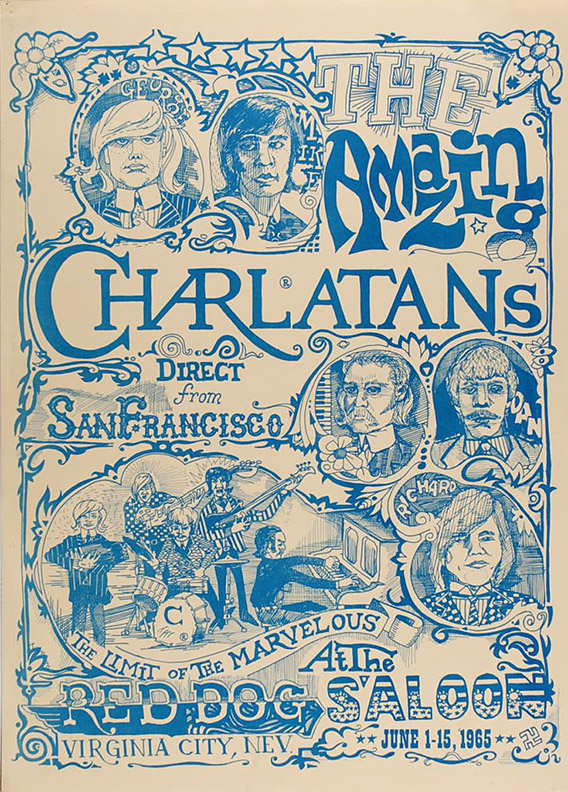HISTORY
Bill Ham was born in Greenville, Mississippi in 1932. He graduated from the University of Houston in 1954 with a Bachelor of Fine Arts Degree. Following two years of military service and a sojourn in commercial \”art\”, he moved to San Francisco in 1959 and began a period of experimentation and studio work. For the next five years Bill worked with mixed media materials, concentrating on direct spontaneous (intuitive) techniques.
In the fall of 1964, he began working with light – electricity. He experimented with kinetic materials, and built a 4\’ x 6\’ light mural \”programmed\” to operate indefinitely. This piece was installed at the RED DOG SALOON in Virginia City, Nevada. \”.. the first S.F. psychedelic light and rock \’n roll show.\’\’ The main focus of his work, however, turned to the possibility of \”painting\” directly with projection. The transparent overhead projector provided a projection system uniquely suitable.
Working in his studio with live and recorded sound, Ham developed a technique of spontaneous projection painting (electric action painting) involving simultaneous composition – execution – and presentation. Ham\’s utilization of electricity for the action painter\’s method of spontaneous composition and execution, introduced several relatively revolutionary elements, including the final step in the abandonment of not only the easel, but the canvas as well. Electric action painting, true to nature itself, ceased to be a \”frozen\” moment or \”finished\” object, and became a series of uninterrupted projected imagery existing only during the time of projection. The \”act\” of painting and \”the \” painting , now existed simultaneously. This unusual quality of momentariness and impermanence required a new painter – viewer relationship. Viewer \”participation\” for such a \”present tense\” art, suggested attendance not only for occasional public presentations, but during studio \”sessions\” as well. As one cannot rehearse spontaneity, the studio sessions have never been related to as \”rehearsals\”, rather as \”shared\” experience. Following months of studio work, in January, 1966, Ham presented three weeks of electric action painting performances in San Francisco. Asisted by Robert Fine with music by William Spencer and Oscar Daniels.
Of these performances, Alfred Frankenstein, San Francisco Chronicle Jan. 1966, said: \”Saturday night… Ham demonstrated the latest and one of the most successful of the numerous efforts which have been made to add the dynamic of motion to abstract painting. What I like most about Ham\’s method is that is is the artist\’s hands at all times. It is a performance. It is action painting that ceases with the action… \”
Philip Elwood, SF Examiner, January 1966: \”Instant art… this is a remarkable happening; a brilliant and beautiful collection of instants which become a whole, like a series of exquisite.. solo choruses. Each individual must gain something by the experience: it is like a living active Rorschach.\”

Performances featuring Bill Ham\’s Light Show at the Avalon Ballroom, SF
The Family Dog Avalon Ballroom
After these first public performances, Ham continued studio work perfecting equipment and techniques for multi-projection audio visual art. In 1966, his work had tremendous popular impact as part of the original San Francisco rock dance light show events. Using multi-image projection techniques, including slide, film, strobe and other special effects, as well as his own distinctive use of the overhead projector with liquids, etc., Ham\’s light show at the Avalon Ballroom in San Francisco did much to \”popularize\” the light show and establish the basic from for the rock dance light show that followed.
Light Sound Dimension
Continuing, concurrently with his work at the Avalon and other dance events, to play with other music in his studio sessions, he explored possibilities for a more integrated experience with jazz, electronic tape music, etc. Two of San Francisco\’s most innovative jazz musicians, Fred Marshall and Jerry Granelli, visited the studio and were invited to improvise. Their parallel experiments with electric sound, and their ability to improvise, provided an unusually rich opportunity for collaboration. These studio sessions resulted in the formation, with Marshall and Granelli, of an audio visual multimedia group, Light Sound Dimension. Ham\’s electric action painting, with the musicians\’ electronic \”orchestral\” sound, proved capable of sustained audio visual improvisation. They were joined by Beverly Bivens, Noel Jewkes, and Flip Nuñez. Playing almost daily, they perfected their unique ability to improvise integrated \”abstract\” audio visual compositions of unusual intensity and richness.
In February, 1967, Light Sound Dimension made its first public appearance at the San Francisco Museum of Modern Art.
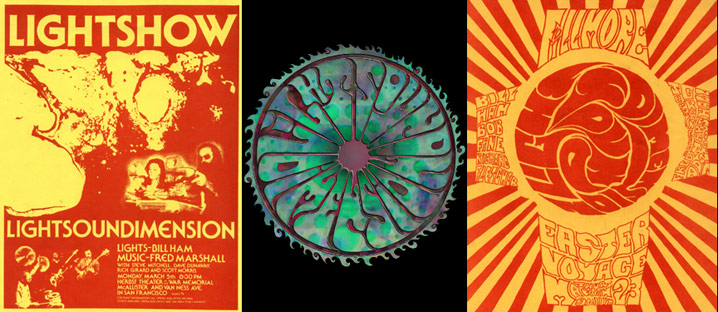
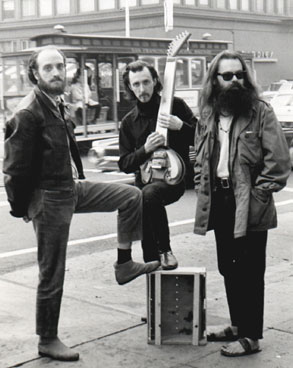
Alfred Frankenstein, San Francisco Chronicle, February, 1967: \”… exciting experiment in light and sound … The technique is highly improvisational … still… the typical composition created on the screen with six or eight projectors Friday night clung as faithfully to principles of abstract form as any carefully premeditated painting… no obvious effort was made to synchronize visual and aural effect but no such effort was needed. The two always go together no matter what.\”
Following these performances, Light Sound Dimension continued studio work with occasional concert appearances, and a six week summer series in Berkeley\’s Live Oak Park Theatre.
R. A. Ogar, Berkeley Barb, Aughust 11, 1967: \”New era for light and sound … describing the total effect is impossible… perhaps the most amazing feature of Light Sound Dimension – given its formal structure – is the fact that the entire performance is improvised and spontaneous. Nothing is prearranged… It\’s all sheer genius.\”
Philip Elwood, San Francisco Exmaniner, October 20, 1967: \”Overwhelming dimension.. the recent Light Sound Dimension offerings in …Live Oak Park Theatre were the most satisfying presentations in the all-senses field of expression this reviewer has ever experienced.\”
THE LIGHT SOUND DIMENSION THEATER
In January, 1968, the Light Sound Dimension Theatre was opened. This unique Light Sound Theatre presented weekly performances of totally improvised light and sound for over a year; as well as private performances and \”animations\” for student and professional groups. Not only did these performances set standards for electric light-sound art, light shows, etc., the Light Sound Dimension Theatre was an unusual achievement as an \”artists\” cooperative theatre, a vital alternative to inadequate, antiquated \”commercial\” presentation policies for contemporary electric art.
Alfred Frankenstein, San Francisco Chronicle: \”Unique work in light and sound… visually the show is very complex and difficult to describe; all one can really say is that the visual effects grow and at the same time grow on you: the whole thing has a living , proliferating quality because it is entirely improvised as it develops to the sound of music… light and sound improvise together for an hour at each showing. No one hour is ever like another. And there is probably no theatre like this one anywhere else on earth.\”
T. Albright, San Francisco Chronicle: \”In the course of 45 minutes or so Ham and his assistants… fill the screen with more visually splendid tableaux than one is likely to see spending a day touring a dozen art galleries.\”
Philip Elwood, San Francisco Examiner, January 15, 1969: \”Still the best light show… in the ensuing 36 months since this writer first reviewed Ham\’s screened improvisations, a staggering amount of music-and-light combinations have gone down… yet in returning, once again, to the L-S-D in their own little theatre at 1572 California, I was taken further out on a more refreshing, boldly imaginative light-sound than I\’ve ever gotten from the more traditional psychedelica that surrounds us… Ham\’s wall-to-wall art projected visuals are utterly unique.\”
After the close of the Light Sound Dimension Theatre in 1969, Ham designed and constructed a multimedia studio for continued light sound experimentation. The development of this new light art has required a parallel development of space for research and \”practice\”. Since 1965, Ham has designed and constructed several studios as well as the Light Sound Dimension Theatre. They have provide an important laboratory space for the technical developments necessary, as well as the opportunity for sustained practice, and an important laboratory space for the technical developments necessary, as well as the opportunity for such an impermanent \”one time\” art form. Studio sessions prior to the Museum show were described by Ralph Gleason, Philip Elwood and others.
Philip Elmwood: \”The trio is rehearsing nightly for a San Francisco Museum of Modern Art series, which promises to be spectacular to eye and ear… the performance cannot be described with words… Even the practice sessions generate such complex sensual reaction that emotional readjustment is necessary when the house light comes on.\”
Ralph Gleason: \”… the images are remarkable in their diversification … accompanied by the improvised music which at times reaches the intensity of a cosmic upheaval… It is an amazing experience and should be impressive at the Museum.\”
Paul Williams, Crawdaddy, March, 1967, New York: \”Light Sound Dimension, the first really tight mixed media group I know of … light and sound really work together; and no matter how familiar you are with the best the Filmore has to offer, you\’ll agree that Ham and Light Sound Dimension are on another level altogether… Their impact on the arts should be tremendous.\”
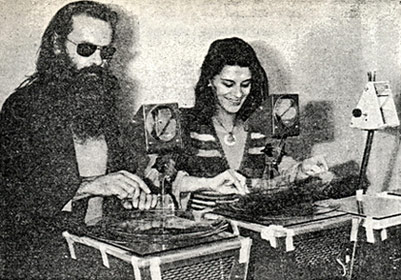
EUROPE
In September, 1970, Ham traveled to Europe where he lived for the next three years in the French Alps near Lake Geneva. He met Sophie Houdet who began to assist Bill with the light show. Bill constructed his studio in Sophie\’s Alps Barn and there, was joined in studio work by the French jazz group XTET. Bill and Sophie\’s first daughter Tara was born in November 1971. Bill presented a performance of Electric Action painting at the Museum of Modern Art in Paris with tapes of the Light Sound Dimension music in February, 1971, and a special series of performances for one week later that year in Montreux, Switzerland with the Light sound dimension musicians from San Francisco, including Marshall and Granelli. In addition, to other presentations with tapes, he presented performances with several European jazz groups and expatriate U.S. jazz musicians including, Steve Lacy, Oliver Johnson and others (City University Paris, Bordeaux Sigma Festival, Houses of Culture in France and Switzerland, Nancy Jazz Festival, etc.).
Claude Maigre, Journal de Geneve, 10.7.71: \”Power to one\’s imagination… resting on the properties of the overhead projector, the light show goes beyond the anecdote aspect of a pseudo-scientific gimmick, to enrich painting with a new media… truly continuous creation… no less than a dynamic form of painting, an instantaneous painting, infinitely perishable… the attention ;quality\’ of the spectators, mostly young, testifies to the power (attraction).\”
Annecy Action Culturelle December, 1972: \”Music to listen to With Your Eyes.\”
SAN FRANCISCO, CALIFORNIA
In November, 1973, Ham returned to San Francisco. Following a period of private experimentation and studio work, he began preparing material for a video project, and plans for further performances of electric action painting. He organized several weeks of informal studio sessions for spontaneous improvisation with musicians from past collaborations as well as with some \”new faces\” including Fred Marshall, Jerry Granelli, Jim Lowe and Steve Mitchell.
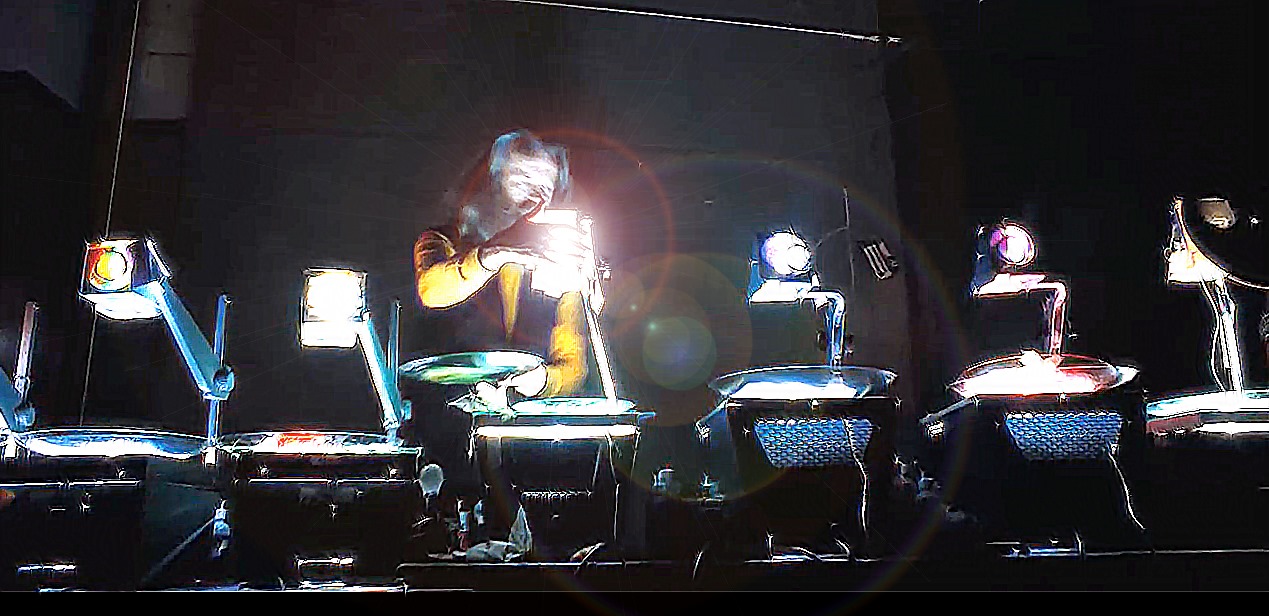
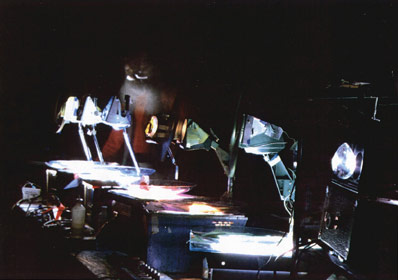
Live Performance LightSounDimension 1979 at the Herbst Theater.
Bill Ham assisted by Sophie Houdet with live music directed by Fred Marshall.
Musicians included Steve Mitchell, Dave Dunaway and Rich Girard.
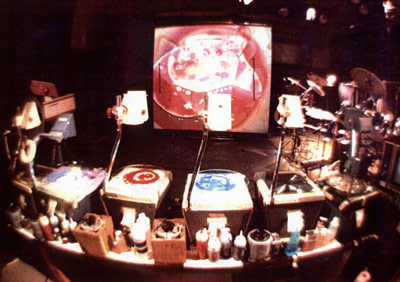
Marin Public Access TV: 7/7/77 Live Video Performance
Bill Ham assisted by Sophie Houdet with live music by percussionist Steve Mitchell.
Although Ham\’s work shares certain common qualities with other light art, it is distinguished by certain unusual accomplishments, His dedications to the improvisational \”action painter\” method of working, has been demonstrated for more than 35 years, in spontaneous performances of electric action painting of rare beauty and compelling power. His unusual ability to spontaneously \”compose\” abstract visual projections into an \”organized\” structured form, distinguish his work from most of the other multimedia light show events.
Bill Ham has pioneered the \”Age of Light Painting\”.

